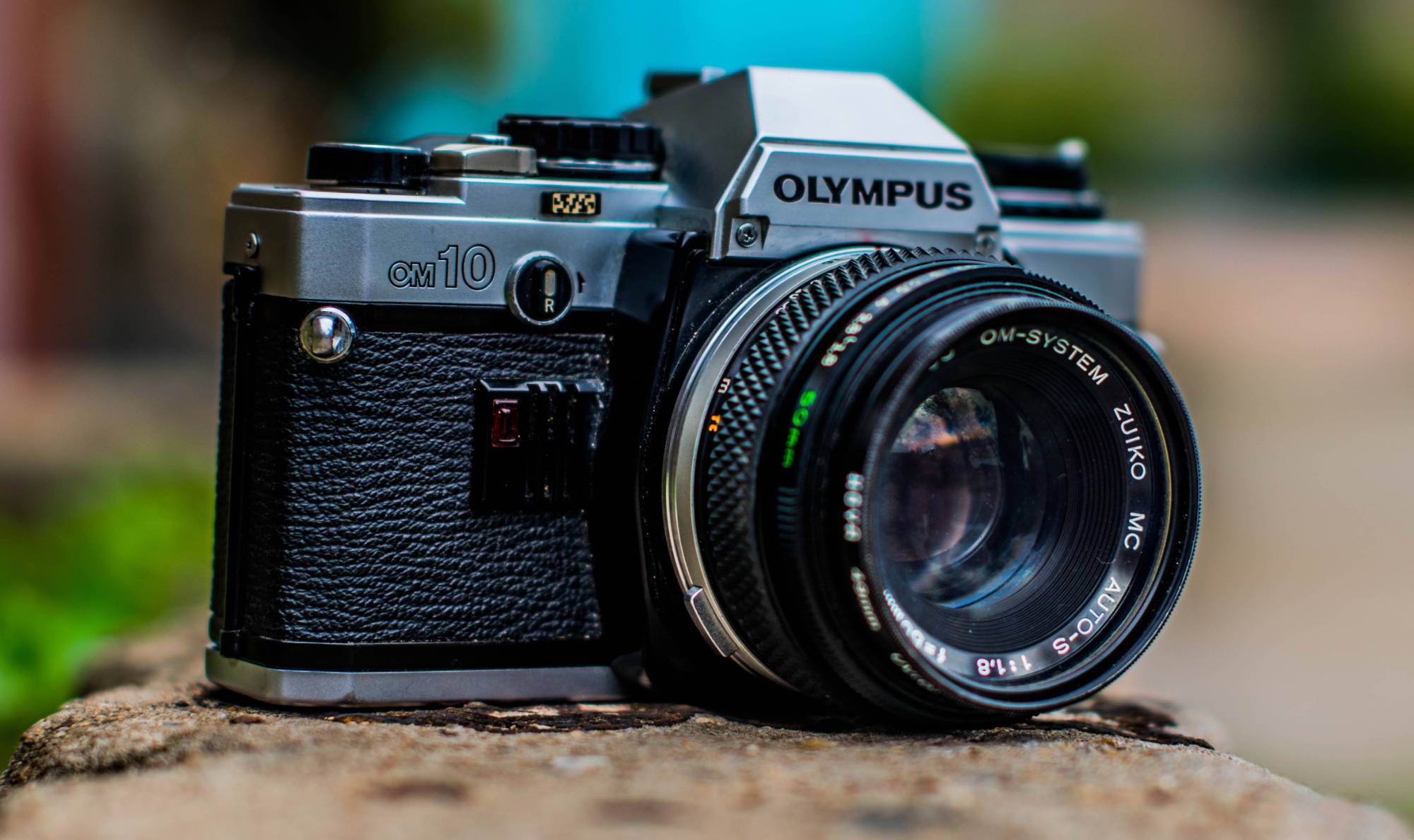
The Best 35mm Film Camera for Beginners - Guest Blog
By J B
Today we are pleased to hand over blogging duties to our new friends over at Filtr Film Cameras. Dan and Jack have recently opened their store and website with the goal of helping people new to analogue photography to find their ideal SLR! And we asked them: so what is the absolute best 35mm film camera for beginners? And this is what they said:
“How can you expect us to choose just one?!”
Fortunately that wasn't the end of the conversation (in the meantime, if you're looking for the Best Films for Beginners then I'd head over to our collection of films sub-£5).
But back to Dan and Jack:
OK, OK. Well, we’ve given it some thought, and after much debate over what makes the best 35mm SLR (and much coffee), we’ve finally come up with our answer.

What Makes a Great Beginner's Film Camera?
To us, as well as being great to look at and a joy to shoot with, to be worthy of the title best 35mm film camera for beginners, a camera needs to be two things: affordable, and easy to use.
There are heaps of otherwise great cameras that don’t meet this brief. The Nikon F2 would be considered by many to be the best 35mm SLR. And for very good reasons. But cheap it ain't. And, if we’re honest, it isn’t especially user friendly either. Certainly not when you haven’t shot with film before.
But before we show you what we think is THE best 35mm film camera for beginners, and explain why we think that, we’ll take a quick look at a couple that narrowly missed out.
[If you don’t know your “Aperture Priority” from your “Program” modes on a camera, you might find it helpful to check out this article before you read on].
(Nearly) the Best 35mm Film Camera for Beginners
The reality is that no single camera is the absolute best 35mm SLR for everyone. Rather there will be several serious contenders for the title, and then it will come down to your precise needs (and budget). That being the case, before getting to our absolute favorite, here are a couple of great 35mm SLR cameras that didn't quite make our number one spot, but which just might make yours!
Pentax Super A
Granted we are suckers for a black body, but we think this is a little beauty. It’s got all the modes you could possibly want - you can shoot fully manual, fully automatic (or “Program” to use the technical term) and everything in between. Perfect for beginners looking for one camera to help them work out what type of shooting they want to do.

You get a great viewfinder display telling you in very clear terms whether you are under or over exposed, and the split focusing screen makes it super easy to nail focus for those precise portrait shots, or night time shooting.
It’s compact and lightweight too, so you’ll never feel it’s too much to carry around with you, meaning when you start falling in love with film, you won’t ever have to be without your Super A!
Probably not the absolute best 35mm SLR ever made. And perhaps not quite the very best 35mm film camera for beginners either. But not far from it. Recommended!
Olympus OM10
This camera started life as an Aperture Priority only camera – in other words, you choose the aperture, the camera picks the shutter speed for you.

We think these aperture only cameras are great for beginners – you’ll get correctly exposed shots every time, meaning you can spend more time thinking about composition and the like.
We’d give this one the edge over some other great Aperture Priority only cameras – like the Nikon EM and the Pentax MV – because for next to no money you can buy a ‘manual adapter’ for the Olympus OM10. Once you fit that, you’ll have a camera that can be Aperture Priority, for most occasions, but that you can switch to manual mode easily, once you have built up your confidence or where the situation requires manual shooting. In our book that makes the OM10 one of the very best 35mm film camera for beginners out there.
The Ultimate, Really, Absolutely, and Truly Best 35mm Film Camera for Beginners
Yes, it's subjective. Yes others may disagree. But as far as we're concerned, this camera is really the best 35mm film camera for beginners available. In fact it is so good that it deserves two big bold titles. Here comes the second one...
The Pentax ME Super
We picked the ME Super due to the beautiful way in which it simplifies the metering process for beginners, meaning it’s super easy to start taking great shots straightaway. Let’s take a look at it in more detail….

Like all Pentax cameras from this period, this camera is gorgeous to look at, and lovely and compact.
But why, then, did we not opt for a different Pentax camera as our choice of the best 35mm film camera for beginners? Well, this gem really is perfect for the beginner, as it comes with a choice of Aperture Priority mode and fully manual shooting. There isn’t another Pentax from this era that comes with just these two options, so it really fits the brief in that respect.
Ok, but why not pick a camera from a different brand with both these modes, you might ask?
Truth is, for many reasons, nearly all those other cameras, like the Nikon FE for instance, are more expensive; these days Nikon and Canon are the dominant brands in Digital SLR photography, so a lot of people look for those brands when they’re buying film cameras, keeping the price high.
Those people are missing a trick though, because back in the 60s and 70s, Pentax were the kings of the film photography world. This means they made lots of great cameras, which sold in big numbers. They were well built too, so there’s lots of them around today in good working condition. That also helps keep the prices down to more affordable levels, which we think is great for the beginner.
But there’s more….
Even if money were no object we think we’d still make this the ultimate beginner's 35mm film camera. And that’s down to 2 main things:
- The revolutionary way in which you change the shutter speed on this camera
- The metering system displayed within the viewfinder. Let us explain.

Before the ME Super, and for a long time after, virtually all SLR cameras used a dial on top of the camera body to change the shutter speed. Once you get used to doing it this way it’s not too much of a problem. But as a beginner it could be ridiculously time consuming and frustrating.
See if this sounds familiar to any beginners out there - You point your camera at your target, you get the focus right, and make sure the composition is spot on. Then, if you want to change the shutter speed you’d typically take the camera away from your eye, hold it down by your midriff to look at the shutter speed, then change the speed.
You’d then lift the camera back to your eye and go back to your target. If you were lucky, it would still be there and you’d fire the trigger – all you’ve done then is waste some time. 9 times out of 10 though, your subject will have moved, meaning you have to re-focus, or moved all together, meaning the shot is lost forever, or the light has changed a bit and you have to get the metering right again, or some combination of those things!
Even when you had been shooting film for a while, changing the shutter speed using a top dial didn’t exactly feel like a natural motion, especially not when you have the camera to your eye – you had to make a claw like grip with your right hand, then find the right dial, then remember to turn it the right way. All a bit of an unnecessary faff really.
The Pentax ME Super refused to be bound by this convention, and did things a different way.

Pentax introduced these little black buttons on top of the body. They were positioned, not by accident of course, in a nice natural position, near to the shutter. In other words, they were close to where you right hand would sit when you had the camera to your eye anyway, so no need to do anything that feels unnatural. One button would speed up the shutter speed – unsurprisingly this was the “up” button, the higher of the two – and the other would slow down the shutter speed.
We challenge anybody to use that way of changing the shutter speed and not find it ten times easier than the more usual top dial. You never had to move the camera away from your eye to find the buttons, and you could make changes in a fraction of a second without losing that precious moment you are trying to capture.
Surprisingly, at the time it wasn’t necessarily a huge hit. Some people just don’t like change perhaps, and there was still a certain amount of a distrust about electrical components in cameras that had, historically, always been mechanical.
Coming to things with an open mind today though, we can’t see any reason not to love this camera and the way in which you change the shutter speed. Certainly as a beginner it feels hugely intuitive and easy to use this feature. We love it, and we think – no, we know – that you will too.
This intuitive feel to the camera didn’t stop there though – it was carried through into the way in which the metering worked; yet another great feature making this our choice for best 35mm film camera for beginners.
[If you don’t understand what exposure is, or what changing the shutter speed does on a camera, have a read of our “Understanding Exposure” article]

Before the ME Super a lot of cameras displayed the metering by showing you a needle, which you had to align in the middle of the viewfinder to get “correct exposure”.
As you can see, the ME Super has a series of numbers along the side of the viewfinder, showing you the shutter speed you’ve selected. If that shutter speed is “under” exposed, the red light at the bottom of that list of numbers will flash, telling you your shot is under exposed. In other words, you need to decrease the shutter speed to get the exposure right.
Now, when you’re new to film, you don’t want to have to be remembering that to increase exposure you need to decrease the shutter speed. You just want to be able to make a quick decision as to which button to press to get the right exposure. Luckily with the ME Super, that’s dead easy.
If the light at the bottom of the metering display is flashing, you press the down button. If the light at the top is flashing – to tell you the shot is over exposed - you press the up button.
Simple.
It sounds like a glaringly obvious way to design a camera, we get that, but at the time it was revolutionary, and for reasons we can’t understand very few cameras adopted this approach afterwards.
These lights would also be orange in colour if the shutter speed you were selecting was slow (1/30s or less) which was particularly useful if you were shooting in the dark and were struggling to read the shutter speed. A nice little bonus.
So, due to its great build quality, it’s compact and lightweight design, it’s reasonable price point, and those two simple but oh-so-effective pieces of design, we crown the Pentax ME Super our choice for best 35mm film camera for beginners. Grab one for yourself, and let us know if you agree. - Filtr
Ready to dive in?
Keep Reading
View all
Shooting Rugby on Film - Sports Photography from 1970
Last week I was invited to join Miles Myerscough-Harris (aka ExpiredFilmClub) at the Tottenham Hotspur Stadium to take photos of a rugby match. Let's see how my photos turned out!

Shooting Film in North Korea: Firsthand Experience
Discover what it’s like to travel to North Korea through the lens of Paul who visited in 2016 to run the Pyongyang Marathon - and take lots of film photos! In this reflective piece explore rare images, personal experiences, and surprising insights from a tightly controlled (yet eye-opening) journey through one of the world’s most secretive countries.

New Year, New Rolls: Setting Film Photography Resolutions for 2025
New year, new rolls, and fresh goals! We've got all you need to make your 2025 film photography resolutions fun, rewarding, and achievable - plus tips for a custom bingo card. Let’s make 2025 your most inspiring analogue year yet!
Subscribe to our newsletter 💌
Sign up for our newsletter to stay up to date on film photography news, sales and events:
Free Tracked Shipping
On all UK orders over £50
Passion For Film
An unbeatable range and an on-site lab
Our Customers Trust Us
Thousands of independent 5* reviews
All Deliveries are Carbon Neutral
Independently audited and verified by Planet
- Opens in a new window.




5 Comments -
B Parkes • -
jeremy north • -
Russ Butner • -
Filtr • -
Christine Pennock •
Personally I’m glad I got into film with a manual camera, but I can see why for an out and out beginner you’d want an aperture (or shutter) priority option.
I agree with Christine’s choice of Praktika. The Pentax ME Super is a good camera but I’d say the MX would be better as it’s mechanical, or a Nikon FM or Olympus OM1 for the same reason. Simple and reliable
Nikon FM.
For fully manual shooting we wouldn’t argue with you. It’s certainly got some awesome styling!
We’d give a slight edge to the Spotmatic though for something of that natur, but horses for courses and all that!
All depends what you want really. We’d give the ME Super the edge due to the top buttons, the viewfinder display and the option to shoot aperture priority.
Love to hear other people’s suggestions though…
The best beginners slr is. Practika MTL5B – simple and cheap and the lenses are too! Carl Zeiss lenses as well